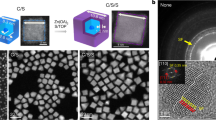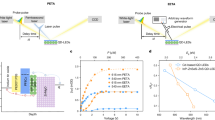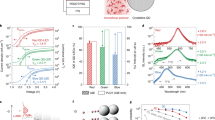Abstract
The electroluminescence performance of heavy-metal-free blue quantum dot (QD) light-emitting diodes (QLEDs) is much lower than that of state-of-the-art cadmium-based counterparts. Ecofriendly ZnSeTe QDs are an ideal alternative to cadmium-based blue QDs1,2, but face issues with colour impurity and inferior stability caused by the aggregated tellurium (Ten≥2) that dominates compositional inhomogeneity3,4. Here we developed an isoelectronic control strategy using congeneric sulfur coordinated with triphenyl phosphite (TPP-S) to construct homogeneous ZnSeTeS QDs with pure-blue emissions and near-unity photoluminescence quantum yield. TPP with low electron-donating capability promotes the reactivity balance among anionic precursors, favouring the growth of QDs with uniform composition. The acceptor-like S with high electronegativity weakens the hole localization of the Te atoms by interfering with their surrounding carriers, thereby suppressing the formation of Ten≥2 isoelectronic centres. Furthermore, the congeneric S increases the configurational entropy of the QDs and eliminates the stacking faults and oxygen defects, leading to improved structural stability and reduced non-radiative carrier density. Consequently, the resulting pure-blue QLEDs based on core–shell ZnSeTeS/ZnSe/ZnS QDs emitting at 460 nm show a high external quantum efficiency of 24.7%, a narrow linewidth of 17 nm, and long operational half-lifetime (T50) close to 30,000 hours at 100 cd cm−2, rivalling state-of-the-art cadmium-based blue QLEDs.
This is a preview of subscription content, access via your institution
Access options
Access Nature and 54 other Nature Portfolio journals
Get Nature+, our best-value online-access subscription
$32.99 / 30 days
cancel any time
Subscribe to this journal
Receive 51 print issues and online access
$199.00 per year
only $3.90 per issue
Buy this article
- Purchase on SpringerLink
- Instant access to full article PDF
Prices may be subject to local taxes which are calculated during checkout




Similar content being viewed by others
Data availability
The data supporting the findings of this study are available within the article and its Supplementary Information. The source data files are available on figshare at https://doi.org/10.6084/m9.figshare.28166900 (ref. 50). Source data are provided with this paper.
References
Kim, T. et al. Efficient and stable blue quantum dot light-emitting diode. Nature 586, 385–389 (2020).
Lee, S.-H. et al. Heterostructural tailoring of blue ZnSeTe quantum dots toward high-color purity and high-efficiency electroluminescence. Chem. Eng. J. 429, 132464 (2022).
Lee, Y. J. et al. Crystallographic and photophysical analysis on facet-controlled defect-free blue-emitting quantum dots. Adv. Mater. 36, 2311719 (2024).
Imran, M. et al. Molecular additive-assisted tellurium homogenization in ZnSeTe quantum dots. Adv. Mater. 35, 2303528 (2023).
Gao, M. et al. Bulk-like ZnSe quantum dots enabling efficient ultranarrow blue light-emitting diodes. Nano Lett. 21, 7252–7260 (2021).
Won, Y.-H. et al. Highly efficient and stable InP/ZnSe/ZnS quantum dot light-emitting diodes. Nature 575, 634–638 (2019).
Dai, X. et al. Solution-processed, high-performance light-emitting diodes based on quantum dots. Nature 515, 96–99 (2014).
Deng, Y. et al. Solution-processed green and blue quantum-dot light-emitting diodes with eliminated charge leakage. Nat. Photon. 16, 505–511 (2022).
Zhang, W. et al. Stable and efficient pure blue quantum-dot LEDs enabled by inserting an anti-oxidation layer. Nat. Commun. 15, 783 (2024).
Chen, X. et al. Blue light-emitting diodes based on colloidal quantum dots with reduced surface–bulk coupling. Nat. Commun. 14, 284 (2023).
Han, C.-Y. et al. More than 9% efficient ZnSeTe quantum dot-based blue electroluminescent devices. ACS Energy Lett. 5, 1568–1576 (2020).
Bi, Y. et al. Reducing emission linewidth of pure-blue ZnSeTe quantum dots through shell engineering toward high color purity light-emitting diodes. Small 19, 2303247 (2023).
Jang, E. P. et al. Synthesis of alloyed ZnSeTe quantum dots as bright, color-pure blue emitters. ACS Appl. Mater. Interfaces 11, 46062–46069 (2019).
Cho, S. et al. Air-stable and environmentally friendly full color-emitting ZnSeTe/ZnSe/ZnS quantum dots for display applications. ACS Appl. Nano Mater. 5, 18905–18911 (2022).
Chang, J. H. et al. Impact of morphological inhomogeneity on excitons states in highly mismatched alloy ZnSe1−xTex nanocrystals. J. Phys. Chem. Lett. 13, 11464–11472 (2022).
Cheng, C. et al. Near-unity quantum yield ZnSeTe quantum dots enabled by controlling shell growth for efficient deep-blue light-emitting diodes. Adv. Funct. Mater. 34, 2313811 (2024).
Smith, A. M., Mohs, A. M. & Nie, S. Tuning the optical and electronic properties of colloidal nanocrystals by lattice strain. Nat. Nanotechnol. 4, 56–63 (2009).
Lin, Y. C. et al. Time-resolved photoluminescence of isoelectronic traps in ZnSe1−xTex semiconductor alloys. Appl. Phys. Lett. 93, 241909 (2008).
Sohn, S. H. & Hamakawa, Y. Binding energies of simple isoelectronic impurities in II–VI semiconductors. Phys. Rev. B 46, 9452–9460 (1992).
Cai, W. et al. Emission mechanism of bright and eco-friendly ZnSeTe quantum dots. Adv. Opt. Mater. 12, 2301970 (2023).
Zheng, Z. et al. Bromide decorated eco-friendly ZnSeTe/ZnSe/ZnS quantum dots for efficient blue light-emitting diodes. Adv. Mater. Interfaces 10, 2202241 (2022).
Neumark, G. F., Kuskovsky, I. L. & Jiang, H. Wide Bandgap Light Emitting Materials and Devices (Wiley, 2007).
Marcet, S., André, R. & Francoeur, S. Excitons bound to Te isoelectronic dyads in ZnSe. Phys. Rev. B 82, 235309 (2010).
Ruberu, T. P. A. et al. Molecular control of the nanoscale: effect of phosphine–chalcogenide reactivity on CdS–CdSe nanocrystal composition and morphology. ACS Nano 6, 5348–5359 (2012).
Park, S. H. et al. Investigation of the crystallinity of N and Te codoped Zn-polar ZnO films grown by plasma-assisted molecular-beam epitaxy. J. Appl. Phys. 108, 093518 (2010).
Kang, C. K. et al. Surface passivation by sulfur treatment of undoped p-CdTe (100). J. Appl. Phys. 88, 2013 (2000).
Wu, J. et al. Temperature-dependent recombination dynamics and electroluminescence characteristics of colloidal CdSe/ZnS core/shell quantum dots. Appl. Phys. Lett. 119, 073303 (2021).
Park, J., Won, Y.-H., Kim, T., Jang, E. & Kim, D. Electrochemical charging effect on the optical properties of InP/ZnSe/ZnS quantum dots. Small 16, 2003542 (2020).
Kalytchuk, S., Zhovtiuk, O., Kershaw, S. V., Zbořil, R. & Rogach, A. L. Temperature-dependent exciton and trap-related photoluminescence of CdTe quantum dots embedded in a NaCl matrix: implication in thermometry. Small 12, 466–476 (2016).
Jha, P. P. & Guyot-Sionnest, P. Trion decay in colloidal quantum dots. ACS Nano 3, 1011–1015 (2009).
Xia, Y. et al. Vertically concentrated quantum wells enabling highly efficient deep-blue perovskite light-emitting diodes. Angew. Chem. Int. Ed. 63, e202403739 (2024).
Yang, Y. et al. High-efficiency light-emitting devices based on quantum dots with tailored nanostructures. Nat. Photon. 9, 259–266 (2015).
Lee, K.-H. et al. Highly efficient, color-pure, color-stable blue quantum dot light-emitting devices. ACS Nano 7, 7295–7302 (2013).
Zhang, X., Li, D., Zhang, Z., Liu, H. & Wang, S. Constructing effective hole transport channels in cross-linked hole transport layer by stacking discotic molecules for high performance deep blue QLEDs. Adv. Sci. 9, 2200450 (2022).
Wang, Y.-K. et al. Self-assembled monolayer-based blue perovskite LEDs. Sci. Adv. 9, eadh2140 (2023).
Cai, F. et al. Defect passivation and electron band energy regulation of a ZnO electron transport layer through synergetic bifunctional surface engineering for efficient quantum dot light-emitting diodes. Nanoscale 15, 10677–10684 (2023).
Yoon, S.-Y. et al. High-efficiency blue and white electroluminescent devices based on non-Cd I–III–VI quantum dots. Nano Energy 63, 103869 (2019).
Li, C. H. A. et al. Mixed Ruddlesden–Popper and Dion–Jacobson phase perovskites for stable and efficient blue perovskite LEDs. Adv. Funct. Mater. 33, 2303301 (2023).
Ghorbani, A. et al. Changes in hole and electron injection under electrical stress and the rapid electroluminescence loss in blue quantum-dot light-emitting devices. Small 20, 2304580 (2024).
Jeong, W. H. et al. In situ cadmium surface passivation of perovskite nanocrystals for blue LEDs. J. Mater. Chem. A 9, 26750–26757 (2021).
Lee, S. et al. Brightening deep-blue perovskite light-emitting diodes: a path to Rec. 2020. Sci. Adv. 10, eadn8465 (2024).
Jiang, K. Y. et al. Efficient deep-blue light-emitting diodes through decoupling of colloidal perovskite quantum dots. Adv. Mater. 36, 2404856 (2024).
Jiang, Y. et al. Synthesis-on-substrate of quantum dot solids. Nature 612, 679–684 (2022).
Zhang, L. et al. Manipulating local lattice distortion for spectrally stable and efficient mixed-halide blue perovskite LEDs. Angew. Chem. Int. Ed. 135, e202302184 (2023).
Cai, F. et al. Charge carrier regulation for efficient blue quantum-dot light-emitting diodes via a high-mobility coplanar cyclopentane[b]thiopyran derivative. Nano Lett. 24, 5284–5291 (2024).
Ravel, B. & Newville, M. ATHENA, ARTEMIS, HEPHAESTUS: data analysis for X-ray absorption spectroscopy using IFEFFIT. J. Synchrotron Radiat. 12, 537–541 (2005).
Kresse, G. & Joubert, D. From ultrasoft pseudopotentials to the projector augmented-wave method. Phys. Rev. B 59, 1758–1775 (1999).
Perdew, J. P., Burke, K. & Ernzerhof, M. Generalized gradient approximation made simple. Phys. Rev. Lett. 77, 3865–3868 (1996).
Flores, E. M., Moreira, M. L. & Piotrowski, M. J. Structural and electronic properties of bulk ZnX (X=O, S, Se, Te), ZnF2, and ZnO/ZnF2: a DFT investigation within PBE, PBE+U, and hybrid HSE functionals. J. Phys. Chem. A 124, 3778–3785 (2020).
Wu, Q. et al. Datasets for “Homogeneous ZnSeTeS quantum dots for efficient and stable pure blue LEDs”. figshare https://doi.org/10.6084/m9.figshare.28166900 (2025).
Acknowledgements
We acknowledge financial support from the Key Research and Development Program of China (2022YFB3602902 and 2024YFB3612404), the National Natural Science Foundation of China (62174104, 61804063 and 62404131), the Program of Shanghai Academic/Technology Research Leader (22XD1421200), the Shanghai Natural Science Foundation (23ZR1423300), the Shuguang Program of Shanghai Education Development Foundation, the Shanghai Municipal Education Commission (number 22SG40), the China Postdoctoral Science Foundation (2023M742197 and 2023M742198) and the Australian Research Council (ARC) Future Fellowship Scheme (GFT210100509). We thank the accelerator scientists and the staff of beamlines BL4B7A at BSRF, BL16U1at SSRF for providing the beam time and User Experiment Assist System of SSRF for their help.
Author information
Authors and Affiliations
Contributions
X.Y. conceived the idea and supervised the work. Q.W., F.C. and S.W. performed most of the synthesis and characterizations of the QDs. G.J. performed the high-angle annular dark-field scanning transmission electron microscopy measurements. Q.W., W.Y., W.H., Z.L. and W.C. carried out the device fabrication and characterizations. Y.Y. carried out the X-ray absorption spectroscopy measurements and directed the data analysis. F.C. and Q.W. wrote the paper, which was revised by X.Z., Jiaqi Zhang, Jianhua Zhang and X.Y. All authors discussed the results and commented on the paper.
Corresponding authors
Ethics declarations
Competing interests
The authors declare no competing interests.
Peer review
Peer review information
Nature thanks Peter Reiss and the other, anonymous, reviewer(s) for their contribution to the peer review of this work
Additional information
Publisher’s note Springer Nature remains neutral with regard to jurisdictional claims in published maps and institutional affiliations.
Extended data figures and tables
Extended Data Fig. 1 Ensemble PL spectra of QD cores.
PL spectra of ZnSeTe cores with various combinations of anionic precursors. Different emissive components were assigned to Ten=1 and Ten≥2 ICs. The third Gaussian curve is caused by the PL emission from higher-order Te ICs.
Extended Data Fig. 2 Spectroscopic analyses by XAS.
a, d, Experimental Zn K-edge XANES spectra. b, e, Fourier-transformed k-space and c, f, R-space of the experimental Zn K-edge EXAFS signals and fitting curves. The Zn K-edge for both samples show apparent peaks around ~2 Å and the same coordination number of 4, which are assigned to the Zn-Se scattering.
Extended Data Fig. 3 XPS spectra of QD cores.
a, Te 3 d of QD-1 core film measured depth profile with different etch times. b, Te 3 d (left) and S 2p (right) of QD-2 core film measured depth profile with different etch times. c, The relative atomic content of Te and S atoms in QD-1 and QD-2 cores as a function of etching depth.
Extended Data Fig. 4 Morphology of QD-2.
a, TEM image of QD-2 core. Scale bar, 10 nm. b, TEM images and a selected-area diffraction (SAED) pattern of C/S/S QD-2. Scale bar, 50 nm in the left and 2 nm in the bottom right corner. The average sizes of QD-2 cores and C/S/S QD-2 are 4.1 ± 0.5 nm and 10.5 ± 1.0 nm, respectively. A clear SAED pattern between the (220) and (311) diffraction planes and lattice distance of 0.32 nm in (111) plane suggest good nucleation and shell growth of QD-2. c, EDS mapping images of Zn, Se, and S elements for C/S/S QD-2.
Extended Data Fig. 5 PL spectra of C/S/S QD-2.
PL spectra of C/S/S QD-2 with an optimal S content of 3% as a function of various Te/(Se+Te+S) ratios. CTe, from 1 mol% to 10 mol%. Inset, photograph of QD-2 solutions under UV excitation.
Extended Data Fig. 6 Device performance of QLEDs based on QD-2.
a–d, EL spectra (a), J-L-V (b), EQE-J (c), and T50 lifetime (d) curves of ZnSeTeS-based devices at the EL peak of 468 nm.
Supplementary information
Supplementary Information
Supplementary Figs. 1–13 and Tables 1–4.
Rights and permissions
Springer Nature or its licensor (e.g. a society or other partner) holds exclusive rights to this article under a publishing agreement with the author(s) or other rightsholder(s); author self-archiving of the accepted manuscript version of this article is solely governed by the terms of such publishing agreement and applicable law.
About this article
Cite this article
Wu, Q., Cao, F., Yu, W. et al. Homogeneous ZnSeTeS quantum dots for efficient and stable pure-blue LEDs. Nature 639, 633–638 (2025). https://doi.org/10.1038/s41586-025-08645-4
Received:
Accepted:
Published:
Issue date:
DOI: https://doi.org/10.1038/s41586-025-08645-4
This article is cited by
-
Highly efficient light-emitting diodes via self-assembled InP quantum dots
Nature Communications (2025)



